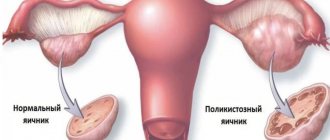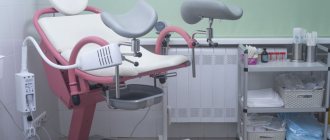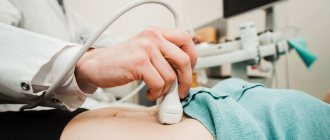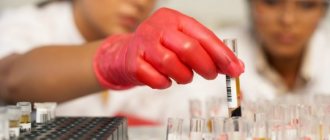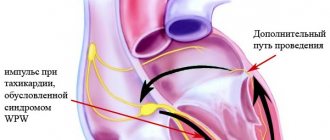Polycystic ovary syndrome (PCOS) is a pathological gynecological disease of the ovaries in a woman, in which cysts and benign tumors appear. Caused by the proliferation of cystic growths inside and outside the ovaries. Appears as a result of disruption of the ovaries, pancreas or pituitary gland. The disease may be congenital and appear in adolescence even before the menstrual cycle appears. Appears as a result of inflammatory diseases and chronic pathologies.
Occurs due to excessive release of male hormone. Therefore, it is often accompanied by obesity and increased hair growth. It most often forms during puberty in girls, but women after menopause are also at risk. The development of cysts on the ovaries prevents the conception of a child or even leads to infertility. Mature women should not develop chronic diseases in order to avoid secondary PCOS.
To determine this diagnosis, a number of studies will be required: examination by a gynecologist, various tests and masks, ultrasound. There is drug treatment, but the only cure for the disease is surgery.
Causes
The first causes are dysfunctions of the endocrine system. The cause of this failure is improper interaction between the ovaries and the hypothalamus. Heredity also has its place in the causes of occurrence. Consider the following reasons:
- Disruption of the pituitary gland and hypothalamus. These organs are responsible for the functionality of the endocrine system, including the ovaries.
- Adrenal failure. The level of male glands in the female body increases.
- Ovarian dysfunction.
- Incorrect functioning of the pancreas.
- Insulin insensitivity, excessive production of it in the body.
Experts cannot determine the exact reasons. There are many reasons why it occurs. Together they cause this syndrome. Increase the likelihood of confirming PCOS:
- obesity of varying degrees;
- injuries in the groin area;
- difficult childbirth;
- hypertension;
- diabetes;
- pathologies of the pituitary gland, thyroid gland or hypothalamus;
- infections;
- congenital pathologies of the female reproductive system;
- termination of pregnancy;
- hypothermia;
- inflammatory processes;
- excessive load;
- change of climate zone;
- mental disorders;
- painful sexual intercourse;
- failure to comply with personal hygiene rules.
Violation of each factor leads to immaturity of the follicle. The remaining underdeveloped parts are formed into brushes, which settle on the ovaries. They can be either single or multiple, reaching different sizes. They are a kind of bubbles with liquid. This pathology occurs in 7% of patients. The proliferation of cysts leads to hyperplasia. Limits reproduction and leads to lack of ovulation. Advanced ovarian syndrome can ultimately lead to endometrial cancer. How to recognize the disease
Based on her feelings and symptoms, a woman will be able to independently recognize her diagnosis. The sensations are quite specific, and if present, you should immediately seek medical help.
When the ovaries are damaged, their structure and function are disrupted. Beginning its development, the pathology from a young girl’s age can be painless and asymptomatic. Most often, the girl does not even suspect its presence. Manifestations can be very diverse:
- Failure of menstruation. There is not only a violation of the cycle, but also its complete absence. Sometimes the absence is accompanied by heavy bleeding.
- Excess body weight. One of the symptoms that is both the cause and the main hormonal imbalance. If you have PCOS, you may notice a sudden weight gain.
- Acne and pimples. All the different forms of acne.
- Increased sweating. The appearance of greasiness, particularly on the scalp.
- Increased hair growth in unintended areas of the female body. Black dense hairs appear. For example, on the chest, fingers, chin, crotch and above the lips of the mouth.
- Drawing pain in the lower abdomen. The pain is transient. It can be given in different directions and be smooth or sharp.
- Inability to conceive. Long attempts to get pregnant do not yield results.
- Change in appearance. A woman acquires masculine facial and body contours.
- Alopecia. Hair loss occurs, as in men. Mainly on the crown and temporal sides of the head.
- Dandruff in hair. Unreasonable appearance. If you didn’t change the water, hygiene products, didn’t wear other people’s hats, etc.
- The appearance of stretch marks. In the abdomen, hips, chest. This is due to sudden weight gain and hormonal imbalance.
- Acanthosis. The appearance of dark spots on the body. In particular, the axillary and papillary area.
- Increasing insulin levels in the blood.
- Hyperplasia. Excess and deficiency of hormones leads to the proliferation of uterine tissue.
- Increased blood pressure.
There are a number of other symptoms that appear less frequently. Statistics show that 50% of women diagnosed with PCOS are obese. The disease may also be accompanied by:
- premenstrual symptoms;
- there is no cycle;
- depression;
- aggressiveness;
- nervousness;
- chronic fatigue;
- lethargy;
- apathy;
- thinking disorder.
Specialist consultation
If you are faced with a problem such as polycystic ovary syndrome, then the treatment of this pathology must be left to an experienced specialist with a wide profile of work. Romanov Georgy Nikitich is an endocrinologist and candidate of medical sciences, his work experience is almost 25 years. He studied in many clinics in the CIS, and also did internships in several Western countries.
Romanov Georgy Nikitich knows modern methods of treating many diseases that are caused by hormonal system disorders. Today, this specialist has the opportunity to help patients from different parts of the country, as well as citizens of other countries - he conducts paid online consultations, remotely studies the results of diagnostic procedures, prescribes and monitors the treatment of his patients. You can contact a specialist in a messenger or social network convenient for you.
Diagnosis and treatment of the disease
Unfortunately, women seek medical help when the diagnosis of infertility cannot be changed. Therefore, doctors insist on regular visits to the examination room. Confirmation of the diagnosis is carried out through various studies.
To begin with, the gynecologist examines the woman in a gynecological chair. Study the medical history, listen to complaints and determine the probable cause of PCOS. Visual examination of the woman - the condition of the skin, hair, physique. Measuring body weight and calculating the index and degree of obesity.
A biochemical blood test is prescribed to determine hormone levels. The presence of polycystic disease will be indicated by the level of FSH and LH. High levels of progesterone and androgen in the blood. Sugar may be elevated and cholesterol levels may be elevated. An ultrasound of the internal genital organs and abdominal cavity is performed. Ultrasound shows the growth of small cysts, enlargement and compaction of ovarian tissue. They conduct studies to determine the absence of the development of malignant tumors - CT and MRI. A scraping from the uterine mucosa will help establish the microflora and conduct research for the presence of hyperplasia. As an additional therapy, a consultation with an endocrinologist is prescribed.
Results and goals of treatment:
1. Restoration of the menstrual cycle.
2. Stimulation of ovulation and conception of a child.
3. Weight correction and improvement of well-being.
4. Elimination of visual problems and discomfort in women.
Reduce calorie intake (from 1200 to 1800 kcal per day). Limit consumption of animal fats. More vegetables and fruits, fiber, vitamins and nutritional supplements are added to the diet. Increases protein and carbohydrate levels. Avoid salty, fried, sweet and starchy foods. Physical activity is also encouraged. Normalization of weight leads to normalization of the menstrual cycle and leads to an improvement in the general condition of the patient.
Treatment of infertility in women consists of two stages: preparatory and the beginning of ovulation. Drugs are used depending on the form and syndrome of the disease. To begin with, reduce insulin levels. Drugs are used that help reduce the sensitivity of the hypothalamus and pituitary gland. For example, Leuprorelin, Buserelin, Triptorelin.
For metabolic disorders, biguanides are prescribed. The dosage and course of treatment are selected individually. Antiestrogens are used to stimulate ovulation. The drug Clomiphene restores ovulation in 65% of women, and pregnancy occurs in every 3 patients.
At the second stage, stimulation of ovulation begins. Based on the results of studies and laboratory tests, a set of medications is prescribed to restore and resume the normal menstrual cycle in young women. If the course of treatment is effective, reproductive function will be restored.
If a woman does not plan a pregnancy, contraceptives are prescribed. Due to their properties, they restore the menstrual cycle. Treatment is carried out under the supervision of a specialist. The course of treatment lasts at least 6 months.
It is divided into 4 types:
1. Removal of the cyst using electric current.
2. The ovarian epithelium is changed by electrical influence.
3. Burning of the follicular formation.
4. Removal of the pathological area of the ovaries.
Only the surgeon can choose the type of intervention. The least traumatic operations are performed. For PCOS, wedge resection is also performed. It leads to the production of androgens and normalizes ovulation. More than 60% of women succeed in becoming pregnant. Unfortunately, the effect lasts only 2-3 years, and then polycystic disease relapses. The first half of the year after surgery is considered the most favorable. A woman should undergo a course of treatment and be under constant supervision by a gynecologist in order to resolve the issue of conception as soon as possible.
How is Stein-Leventhal syndrome treated?
Despite the fact that the exact causes of PCOS are unknown, modern medicine has developed methods for correcting hormonal levels and treating infertility. One of the important factors in restoring hormonal levels is the fight against excess weight. Changes in the sensitivity of insulin receptors cause increased formation of adipose tissue and weight gain. And adipose tissue is capable of synthesizing estrogens, the increased level of which, through feedback, reduces the production of follicle-stimulating hormone (FSH). Therefore, the fight against excess weight plays an important role in the treatment of polycystic ovary syndrome complicated by infertility. After all, FSH stimulates the growth of follicles and the full maturation of the egg.
Development of follicles under the influence of hormones
If you are diagnosed with polycystic ovary syndrome, in addition to drug treatment, it is recommended to play sports or exercise, and walk in the fresh air more often. Physical activity increases muscle sensitivity to insulin. You also need to eat right. If all this does not help, you may have to resort to liposuction.
In many cases of PCOS, a reduction diet is prescribed during treatment, which helps not only to cope with excess weight, but also to normalize lipid and carbohydrate metabolism. The diet consists of reducing daily caloric intake. Of the required 2000 kilocalories, carbohydrates make up 52%, fats - 32% (of which a third are unsaturated fats), proteins - 16%. The intake of hot, spicy, salty foods, marinades, and liquids is limited. Fasting days are observed. You should not starve, this negatively affects glucogenesis.
Often, with PCOS, treatment for which is selected strictly individually, patients are prescribed oral contraceptives, this helps to temporarily normalize cycle disorders and reduce the severity of symptoms, but they can be used up to 35 years of age, in addition, they are not recommended if the woman smokes.
Rehabilitation
Pain begins a few hours after surgery. Painkiller injections are used. The pain will decrease over time as it heals. If the pain lasts longer than a week, complications may develop. The stitches are removed within 7-10 days. Full recovery after surgery occurs in 4 to 8 weeks. Menstruation returns within a couple of weeks. Ovulation is getting better.
If the amount of tissue removed is of normal size, then there is a chance of getting pregnant. During the first weeks, sexual intercourse is excluded, and after pain and healing have passed, you can begin to conceive. If pregnancy has not occurred within a year, you should again seek gynecological consultation to exclude the diagnosis of complete infertility.
The consequence of resection may be the rapid onset of menopause. The second type of complication is adhesions. These are fusions between the intestines and genitals, which prevent pregnancy from occurring. Infectious and inflammatory processes may develop, hematomas or hernias may appear, and internal bleeding may occur.
Infertility is the complete absence of ovulation. It may not occur at all or occur periodically up to 3 times a year. Lack of ovulation and hormonal imbalances lead to infertility. The advanced process of polycystic disease increases the risk of developing benign and malignant tumors, as well as uterine and breast cancer. The disease is accompanied by obesity, baldness and diabetes. Disruptions of the endocrine system lead to heart attack, stroke, kidney and liver diseases. Detection and treatment of PCOS in the early stages significantly reduces the risk of developing irreversible processes and increases the chance of returning to normal sexual and reproductive life.
Types of polycystic ovary syndrome
According to the mechanism of development, polycystic disease is of two types:
- Primary.
Caused by disruption of the hypothalamic-pituitary system. Occurs in 85% of cases. It is hereditary in nature and involves a disruption in the production of a number of enzymes. With this type of disease, the ratio in the production of luteinizing and follicle-stimulating hormones is disrupted. Often the pathology is accompanied by insulin resistance, which indicates serious metabolic disorders. - Secondary.
Caused by dysfunction of the adrenal cortex. This type of polycystic disease develops as a result of previous infections, abortions, difficult childbirth, hormonal treatment, and stress. The main cause of polycystic disease is the pathological secretion of gonadotropin, which leads to metabolic disorders.
